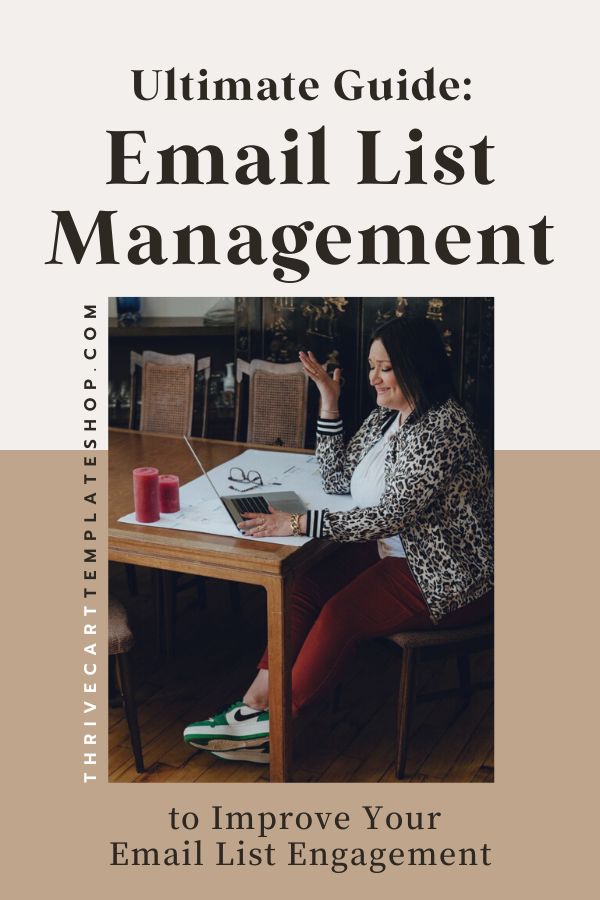

Welcome to the ultimate guide on email list management! The money is in the list, so building and maintaining an engaged email list is crucial for any business or organization.
Whether you’re a seasoned marketer or just starting out, understanding the intricacies of effectively managing your email list can significantly improve your engagement rates, maximize the value of your subscribers, and have a tremendous impact on your business’ revenue. In this blog post, we will delve into various strategies, tips, and best practices that will help you master the art of email list management.
Why Email List Management Is Important
Email list management is essential for businesses that want to create a solid email marketing strategy. Building and maintaining an engaged email list allows businesses to effectively communicate with their audience and maximize their marketing reach. By managing your email list, you can ensure that your messages are delivered to the right people at the right time, increasing open rates and click-through rates.
Proper email list management helps improve engagement rates. By segmenting your subscribers based on their interests or behavior, you can send targeted emails that are more relevant to each individual. This personalization increases the likelihood of recipients opening and engaging with your emails.
In addition, managing your email list keeps it healthy and up-to-date. Regularly removing inactive or unengaged subscribers helps maintain a high deliverability rate by preventing emails from being marked as spam. It also ensures that you have an accurate understanding of the size and quality of your subscriber base.
Effective email list management is crucial for increasing engagement rates, optimizing marketing efforts, and maintaining a healthy subscriber base.
Are You Using the Right Email Marketing Service?
Do you feel constantly less than thrilled with your current ESP, all it can (and can’t) do for you, even though you might be paying a mint for the monthly service?
If you aren’t sure if you are using the right email marketing service platform or are having trouble figuring out your tech, you’ll want to check out Email Service Matchmaker. In that $9 workshop, I compare and contrast the most popular email service providers out there for coaches, course creators, template shop owners, and digital product sellers and make recommendations based on where you’re at in business. Also included: a feature and price comparison chart of all the most popular email service providers.
Email List Management Best Practices
Effective email list management includes regular list cleaning, strategic and consistent segmentation, as well as gaining explicit consent from subscribers when they join your list. By following these best practices, businesses can really make the most of their email lists, making it the most valuable assert in their business.
1) Email Regularly and Consistently
Regularly and consistently sending emails is one of the key strategies for effective email list management. By establishing a consistent schedule, you can create anticipation and trust with your subscribers. Whether it’s once a week or once a month, sticking to a regular routine helps maintain engagement and keeps your brand top of mind.
Additionally, consistency in email delivery builds credibility and reliability, increasing the likelihood that your recipients will open and engage with your messages.
Sending emails regularly also allows you to stay connected with your audience and nurture relationships. It enables you to provide valuable content, updates, and promotions while avoiding being perceived as spammy or irrelevant. By being present in their inbox consistently, you have more opportunities to connect, share important information, drive conversions, and ultimately build customer loyalty.
Making it a habit to send emails regularly and consistently is an essential aspect of effective email list management. Not only does it establish trust and credibility with your subscribers but also enables you to stay connected with them over time.
2) Clean Your Email List Regularly
Cleaning your email list regularly is a vital practice for any business or organization. Over time, email addresses become outdated or inactive, leading to lower engagement rates and wasted resources.
By regularly purging your list of these inactive subscribers, you can improve the efficiency and effectiveness of your email campaigns. Not only will this increase open and click-through rates, but it will also optimize deliverability by reducing the chances of landing in spam folders.
Don’t underestimate the power of a clean email list – removing inactive subscribers – it will not only boost performance like deliverability and click rates but also enhance the overall success of your marketing efforts.
By focusing on quality over quantity, you can engage with an active subscriber base that is more likely to convert into customers or loyal followers. So take the time to cleanse your email list regularly – it’s an essential step towards maximizing engagement and getting the most out of each campaign.
3) Monitor Your Email Marketing Analytics
By tracking and analyzing the performance metrics of your campaigns, you can gain valuable insights into what works and what doesn’t. This data allows you to make informed decisions about your email strategy, ensuring that you are delivering content that resonates with your subscribers and ultimately increases engagement rates.
Through monitoring your email marketing analytics, you can track key metrics such as open rates, click-through rates, conversion rates, and bounce rates.
These metrics provide important feedback on the effectiveness of your subject lines, content quality, and overall campaign performance. By regularly reviewing this data, you can identify trends or patterns in subscriber behavior and adjust your strategies accordingly.
Successful email list management requires ongoing analysis of these analytics to optimize campaign performance.
Email Marketing Analytics to Track
Email marketing analytics is an essential tool for tracking the performance of your email campaigns. By analyzing key metrics, such as open rates, click-through rates, and conversion rates, you can gain valuable insights into the effectiveness of your emails and make data-driven decisions to improve engagement.
Additionally, by monitoring bounce rates and unsubscribe rates, you can identify any issues with your email list hygiene or content that may be causing recipients to disengage.
With access to detailed data on subscriber behavior and engagement levels, you can refine your strategies and deliver more relevant and impactful messages.
Email List Growth Rate
Email list growth rate refers to the speed at which an email list expands over time. It is a key metric that measures the success of your email marketing efforts and indicates how well you are attracting new subscribers.
To increase your email list growth rate, it’s important to employ strategies such as creating compelling lead magnets or incentives that encourage people to subscribe, optimizing sign-up forms on your website and landing pages, and leveraging social media channels to promote your email list.
So, while we are focused on quality over quantity when it comes to our email list size… email list growth rate is still something you’ll want to track.
Final Thoughts
Mastering the art of email list management is essential for all businesses. It allows you to build and maintain an engaged audience, improve your engagement rates, and maximize the value of your subscribers.
By implementing various strategies and best practices discussed in this guide, you can transform your email campaigns into captivating experiences that drive results.
Stay proactive in adapting new tactics as technology evolves and customer behavior changes so that you can consistently excel at engaging with your audience through their inbox.
Other posts you may want to check out:
- ThriveCart and Encharge Integration Explained: Pros, Cons, and Real Talk
- What is a VSL Funnel & How to Build One in Thrivecart
- 6 Simple Ways to Improve Your Order Confirmation Page in Thrivecart
- Is Your Subscription Membership About To Violate Federal Law?
- Recurring Revenue Businesses: The Pros and Cons of This Business Model
